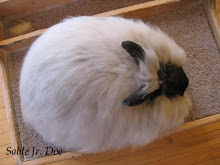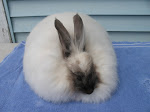I had all kinds of cute little baby pictures (and Sr. pics) to post tonight, but my camera suddenly went kaput on me and refused to download anything into my computer:(. I had meant to talk about current events in ADDITION to nestbox stuff, but it seems that that is not to be today because no one will know what I am talking about without the visual aids, and there is no sense in creating confusion, LOL.
Anyhow--just quickly--the litters are growing like crazy and the first 3 batches will be ready to go out with mom permanently next Wednesday. An interesting thing that is happening (that I should have posted pictures of, too:( ), is that there is a huge difference in size between the purebred litters and Echo's litter (the F2/NZ Cross doe). I don't mean the size of the litter itself, but the size of each individual baby within both groups. Hybrid vigor is an amazing thing and obviously increases size and weight of the offspring instantly. Babies in Echo/Pierre's litter are literally twice the size of Juno's simply because Juno's are so inbred. Genetically speaking her babies will be more uniform in type and wool due to a higher level of homozygosity, but as Echo's babies get bred and rebred within the same line a similar effect will take place with them too.
I took Devaki's coat off today also because she went off feed completely a short time ago (don't worry, I got great pics of her in full coat first that I will post ASAP, LOL). While I was hoping to enter her at Rhinebeck on April 19 there was no way she was going to hold out another 2 weeks, so I decided it was better to be safe than sorry. She has her haircut now and I will breed her sometime over the next few weeks.
__________________________________________________
The fun thing about litters (IMO) is that there are all kinds of interesting opportunities to observe nestbox behavior. I have found over the years that babies tend to follow predictable patterns before, during, and after being fed, and while this is something that I intend to get detailed pictures of in the future (I swear it!), for now I will just give a detailed verbal description:).
Step 1--Pre-Nursing:
Most, but not all, does feed their litters very early in the morning. Here in my rabbitry each doe feeds only once a day, each mealtime spaced approx. 24 hours apart. Right before nursing (up to an hour or so ahead of time), each litter works it's way up to the surface of the nest in order to take full advantage of the 5 min. feeding session. In wintertime especially, the litters bury themselves deep beneath the wool and hay to stay warm, but in the summer they tend to stay nearer to the surface, sometimes sleeping with no coverage at all. Baby rabbits are excellent thermal regulators when it comes right down to it. When I first began raising litters I used to fuss and cover everyone up when I felt they weren't doing it themselves, but I quickly realized that they monitor their temperatures 100% perfectly, and that nothing whatever needs to be done to help them out.
Right before feeding the babies are exposed and ready to nurse. In addition to this they often squeak and wiggle around vigorously to let the doe know they are hungry. Once the doe jumps into the box (which can be right away or after a dawdle and extended face/paw washing), she will nurse approx. 5-10 minutes. Once she is finished she will either turn around and jump out, or jump directly out from whatever position she happens to be in. It is better if she turns around before hopping out because there is less chance of dragging babies out that way, but it is good to be nearby to scoop babies up who have come out with the doe anyway. At this point, motherly attention is finished for the day and most does will behave from that point as though the litter did not even exist (until the next feeding time, of course:)).
Step 2--During Nursing:
During the nursing period the babies fuss about at first, kicking back and forth below the doe and changing nipples repeatedly. After the first minute or two has passed they settle in and begin nursing in earnest, which will continue determinedly until the doe jumps out and cuts off the supply:). It is actually critically important for the doe to this though it seems abrupt, because kits in general are feeding machines who will continue to nurse until they are literally forced to stop. If the doe did not put a quick end to the feeding at the appropriate time, the babies would engorge themselves without fail and die.
A very common belief in rabbits is that the doe must clean each kit individually after nursing in order for it to urinate. While it is important that the litter is stimulated to go to the bathroom (for lack of a better term), very, very few does actually take the time to clean their babies directly after feeding. According to the book 'Rabbit Production', the act of nursing itself provides more than enough moisture in the nest to stimulate urination from milk spilling as the babies feed. It is rarely necessary for the doe to do anything extra.
Step 3--Post Nursing:
After nursing, the litter is temporarily in a comatose state (LOL). For several seconds everyone seems to lack the energy to get up and roll around on their fat bellies, so they lay down for a moment and vegetate:). Then suddenly, everyone perks up and begins to dig and scratch frantically into the nesting material. What is happening now is that the litter is actively fluffing and drying out the nest after feeding and urinating. The nest must be as dry as possible before sleeping so that no one gets chilled, and once that is finished, everyone piles up to go to sleep. Again, if it is cold the litter will cover itself completely. If it is warm or hot they won't bother, but bunny babies will always sleep in a pile no matter what unless someone is about to fade, in which case the dying baby will work itself off into a corner of the nest to avoid chilling the rest of the litter.
__________________________________________________
Here a little bit about nestbox behavior, particularly up to the age of approx. 2 weeks. After the second week a litter tends to stay awake and move around a bit more, and by the time week 3 rolls around they are ready to leave the nestbox completely and go about the business of being real rabbits:).
More again next week (with pictures this time, I promise!), and I hope that Spring is turning up in every part of the country by now, with gardens growing and lots of bunnies breeding:).
Have a great week!
Sunday, March 30, 2008
Subscribe to:
Post Comments (Atom)























2 comments:
excellent description!! Very insightful. I also believe that the act of bunnies bumping and wiggling against eachother acts as a stimuli to make them urinate. In almost 30 years, i have never seen a doe actually clean kits or do that to make them urinate.
Very good blog. I enjoy it.
That was really informative. As a first time french angora owner (one little doe, with a buck and another doe or two planned for in the future) your blog is one of the best angora rabbit blogs I have found! Great work, putting you on my bloglines roll!
Post a Comment